 Chasen's Chili - a classic, but not historically accurate.
There was a video made by my sister some time ago when I was maybe 11. You won’t find it on YouTube; it was filmed on Betamax and remains in that format. In it, I play a young fellow named Dennison who is a fan of canned chili. I eat a bowl of Hormel’s and the sounds of flatulence (and hilarity) ensue. As a fan of videography, my sister went on to become a successful director. As a fan of canned chili, I went on to become a successful glutton with a blog nobody reads.
Back then, I knew of two types of chili: with beans and without beans. From those two cans, I formed my concept of what chili was. As my palate became more sophisticated in college, I learned to make my own chili, substituting fancy little black beans instead of vulgar kidney beans, and ground turkey meat instead of industrial grade beef. It’s a pretty basic recipe: ground meat, browned with some onions and garlic. Add some cooked beans, canned tomatoes, chili powder, cumin, maybe a little cocoa, more chilis, fresh peppers and some liquid (a beer and some bean juice) and after an hour of simmering, you’ve got chili.
I was eating lunch at the school lab when a woman from Texas scoffed at my Tupperware bowl saying, “Real chili doesn’t have tomatoes or beans.” I shrugged through a mouthful of deliciousness, “So?” I kick myself that it’s taken me 20 years to get to the root of what she meant.
As it turns out, the roots of chili are found in 19th century Texas, where it was made as a stew from cheap meat. Similar stews were made previous to that but it wasn’t until the 1850s that there were reports of a “brick chili” made of pressed mashed chile peppers, beef and spices that was often reconstituted and eaten on long journeys. This happened to emerge at the same time that there was an influx of Polish immigrants into Texas. Coincidence? I think not. Think of how paprika was such a big deal in Europe thanks to Columbus and subsequently, the influence of the Austria-Hungarian Empire. The immigrants came here and used the next best thing: Mexican chiles.
Chasen's Chili - a classic, but not historically accurate.
There was a video made by my sister some time ago when I was maybe 11. You won’t find it on YouTube; it was filmed on Betamax and remains in that format. In it, I play a young fellow named Dennison who is a fan of canned chili. I eat a bowl of Hormel’s and the sounds of flatulence (and hilarity) ensue. As a fan of videography, my sister went on to become a successful director. As a fan of canned chili, I went on to become a successful glutton with a blog nobody reads.
Back then, I knew of two types of chili: with beans and without beans. From those two cans, I formed my concept of what chili was. As my palate became more sophisticated in college, I learned to make my own chili, substituting fancy little black beans instead of vulgar kidney beans, and ground turkey meat instead of industrial grade beef. It’s a pretty basic recipe: ground meat, browned with some onions and garlic. Add some cooked beans, canned tomatoes, chili powder, cumin, maybe a little cocoa, more chilis, fresh peppers and some liquid (a beer and some bean juice) and after an hour of simmering, you’ve got chili.
I was eating lunch at the school lab when a woman from Texas scoffed at my Tupperware bowl saying, “Real chili doesn’t have tomatoes or beans.” I shrugged through a mouthful of deliciousness, “So?” I kick myself that it’s taken me 20 years to get to the root of what she meant.
As it turns out, the roots of chili are found in 19th century Texas, where it was made as a stew from cheap meat. Similar stews were made previous to that but it wasn’t until the 1850s that there were reports of a “brick chili” made of pressed mashed chile peppers, beef and spices that was often reconstituted and eaten on long journeys. This happened to emerge at the same time that there was an influx of Polish immigrants into Texas. Coincidence? I think not. Think of how paprika was such a big deal in Europe thanks to Columbus and subsequently, the influence of the Austria-Hungarian Empire. The immigrants came here and used the next best thing: Mexican chiles.
 The chili vendors of San Antonio
To be honest, I’m totally talking out of my ass. I have no evidence to back up the Eastern European roots of chili but it kind of makes sense, right? Goulash? Chili? Both are bowls of red?
I now continue with my out-my-ass history: Chili became popular in Texas and then traveled northward to the 1893 World’s Fair in Chicago. In its six-month run, 27 million people attended the fair and witnessed firsts like the Ferris Wheel and alternating electrical current (yes, I read Eric Larson’s Devil in the White City). Those same millions also had the chance to try “San Antonio Chilley” at the Texas exhibit. From there the dish slowly gained in popularity.
The chili vendors of San Antonio
To be honest, I’m totally talking out of my ass. I have no evidence to back up the Eastern European roots of chili but it kind of makes sense, right? Goulash? Chili? Both are bowls of red?
I now continue with my out-my-ass history: Chili became popular in Texas and then traveled northward to the 1893 World’s Fair in Chicago. In its six-month run, 27 million people attended the fair and witnessed firsts like the Ferris Wheel and alternating electrical current (yes, I read Eric Larson’s Devil in the White City). Those same millions also had the chance to try “San Antonio Chilley” at the Texas exhibit. From there the dish slowly gained in popularity.
 "Cincinnati Five-Way" or "Five More Reasons to Never Visit Ohio"
In 1902, William Gebhardt began selling Eagle Brand Chili Powder (now owned by ConAgra. Yay!) and nine years later was the first to distribute canned chili nationwide. In 1922, the Empress chili parlor opened in Ohio, which helped popularize the Cincinnati style of chili, which is a tepid, blandish version served over mushy spaghetti. But there were other Midwestern versions that predated them, like in 1913, Chili John’s opened in Green Bay, Wisconsin where it still exists today. Their only other franchise is in Burbank, California, where they serve hot and mild ground beef chili as well as a bean variant. It's a slightly gutsier version of the Cincinnati style (as gutsy as a spicy dish from Green Bay could be). But the ground meat tastes so institutional. My guess is that the ground beef so popular today came out of laziness – it takes a long time to stew chunks of meat vs. ground meat. And beans came out of cheapness. These were lean times in American history and the spices married pretty well with beans. Why not add it to stretch out the beef?
Gladwell on Moskowitz (if you haven't seen this, you should)
Thus it’s no surprise that chili took off in the canned food revolution, from which, thanks to food expert, Howard Moskowitz, we have 12 varieties of Hormel’s chili, 12 of Stagg and 9 of Dennison’s. Not to mention all the other generic and froofy chilis.
"Cincinnati Five-Way" or "Five More Reasons to Never Visit Ohio"
In 1902, William Gebhardt began selling Eagle Brand Chili Powder (now owned by ConAgra. Yay!) and nine years later was the first to distribute canned chili nationwide. In 1922, the Empress chili parlor opened in Ohio, which helped popularize the Cincinnati style of chili, which is a tepid, blandish version served over mushy spaghetti. But there were other Midwestern versions that predated them, like in 1913, Chili John’s opened in Green Bay, Wisconsin where it still exists today. Their only other franchise is in Burbank, California, where they serve hot and mild ground beef chili as well as a bean variant. It's a slightly gutsier version of the Cincinnati style (as gutsy as a spicy dish from Green Bay could be). But the ground meat tastes so institutional. My guess is that the ground beef so popular today came out of laziness – it takes a long time to stew chunks of meat vs. ground meat. And beans came out of cheapness. These were lean times in American history and the spices married pretty well with beans. Why not add it to stretch out the beef?
Gladwell on Moskowitz (if you haven't seen this, you should)
Thus it’s no surprise that chili took off in the canned food revolution, from which, thanks to food expert, Howard Moskowitz, we have 12 varieties of Hormel’s chili, 12 of Stagg and 9 of Dennison’s. Not to mention all the other generic and froofy chilis.
 This explosion of made up varieties is when I entered the chili fray. But to me, the different cans all tasted basically the same – fine, but vaguely dog-foody. The Los Angeles regional fast food version of chili is a pasty goo slopped from a metal spoon glistening with bright orange grease on a shriveled hot dog. Maybe edible at 2AM while you’re trying to sober up, but it’s not what you would call “good.”
This explosion of made up varieties is when I entered the chili fray. But to me, the different cans all tasted basically the same – fine, but vaguely dog-foody. The Los Angeles regional fast food version of chili is a pasty goo slopped from a metal spoon glistening with bright orange grease on a shriveled hot dog. Maybe edible at 2AM while you’re trying to sober up, but it’s not what you would call “good.” As appetizing as it looks
In the face of all these less than tasty versions of chili, my recipe for black bean and pasilla chile chili became my ideal chili. Until I learned more about true Texas chili.
As appetizing as it looks
In the face of all these less than tasty versions of chili, my recipe for black bean and pasilla chile chili became my ideal chili. Until I learned more about true Texas chili.
 Every braise starts with a good browning.
Stem and seed them then toss them in a blender with some water, garlic, oregano, a bit of sugar and toasted cumin seeds. Back in the main pot, sauté a finely chopped onion, then add the browned meat, the chiles, some beef stock and a couple tablespoons of corn meal (for thickening) and simmer for a couple hours. After that, taste it, adjust the seasonings (add cayenne for more heat, or whatever) and add a tablespoon or so of white or cider vinegar to liven things up. Cook it another few minutes and adjust seasonings and thickness (add more water if it’s too thick). I usually cook it a day ahead of time to give time for the sauces to permeate the meat.
Every braise starts with a good browning.
Stem and seed them then toss them in a blender with some water, garlic, oregano, a bit of sugar and toasted cumin seeds. Back in the main pot, sauté a finely chopped onion, then add the browned meat, the chiles, some beef stock and a couple tablespoons of corn meal (for thickening) and simmer for a couple hours. After that, taste it, adjust the seasonings (add cayenne for more heat, or whatever) and add a tablespoon or so of white or cider vinegar to liven things up. Cook it another few minutes and adjust seasonings and thickness (add more water if it’s too thick). I usually cook it a day ahead of time to give time for the sauces to permeate the meat.
 My new chili standard
The result is stunning for such a simple preparation. Where my ground meat chili is all about secret spice blends, fresh peppers, exotic beans, outrageous hotness, weird meat mixes and other culinary obfuscations, this Texas chili is just about the beef and the chile. That’s all you can see and taste. This past weekend I made it for a campout and I spent most of dinner just sopping up the sauce with cheap white bread. It was a revelation.
My new chili standard
The result is stunning for such a simple preparation. Where my ground meat chili is all about secret spice blends, fresh peppers, exotic beans, outrageous hotness, weird meat mixes and other culinary obfuscations, this Texas chili is just about the beef and the chile. That’s all you can see and taste. This past weekend I made it for a campout and I spent most of dinner just sopping up the sauce with cheap white bread. It was a revelation.


 I’ve steamed and shelled my Dungeness crabs before, but it’s a huge pain in the ass. I have to drive a ways to get the live ones, then I have to go through the ordeal of cooking the poor little things and then it takes me a good hour to shell two crabs. It’s so much easier to walk down the street to Trader Joe’s, grab a one pound can of Chicken of the Sea claw meat and pop it open. Plus, it costs less than half as much and tastes almost as good. Blue swimming crab ain’t no Dungeness and its sustainability is in
I’ve steamed and shelled my Dungeness crabs before, but it’s a huge pain in the ass. I have to drive a ways to get the live ones, then I have to go through the ordeal of cooking the poor little things and then it takes me a good hour to shell two crabs. It’s so much easier to walk down the street to Trader Joe’s, grab a one pound can of Chicken of the Sea claw meat and pop it open. Plus, it costs less than half as much and tastes almost as good. Blue swimming crab ain’t no Dungeness and its sustainability is in 
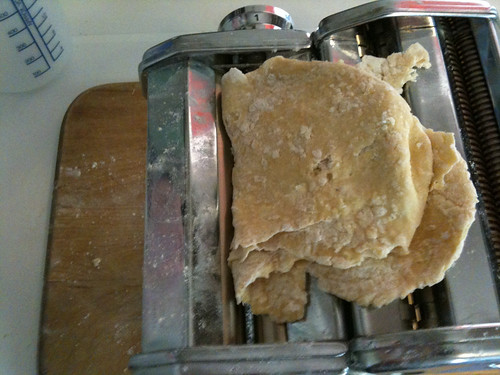
 Cut it in fourths (with your trusty pastry scraper) and start feeding it one of the fourths into your pasta machine (set at 1, the widest setting). It’ll come out ugly, but after you fold it and re-feed it, it will knead into something smooth and manageable. At that point, you feed the pasta through the machine a successively higher numbers on your pasta machine. By the end, you should have a long, wafer thin ribbon of pasta.
Cut it in fourths (with your trusty pastry scraper) and start feeding it one of the fourths into your pasta machine (set at 1, the widest setting). It’ll come out ugly, but after you fold it and re-feed it, it will knead into something smooth and manageable. At that point, you feed the pasta through the machine a successively higher numbers on your pasta machine. By the end, you should have a long, wafer thin ribbon of pasta.

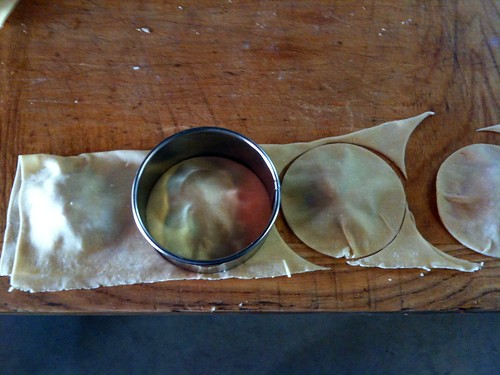 At this point, I take each one to check the seal and ensure there’s no air in the ravioli. Air pockets are bad. Then I layer the ravioli with parchment paper and store them in the freezer to keep them from getting mushy. If you store them for longer than a couple hours, make sure they're in an airtight container or they'll dry out and crack. Two cups of flour should make around 60-70 ravioli, which should match a one pound can of crab.
At this point, I take each one to check the seal and ensure there’s no air in the ravioli. Air pockets are bad. Then I layer the ravioli with parchment paper and store them in the freezer to keep them from getting mushy. If you store them for longer than a couple hours, make sure they're in an airtight container or they'll dry out and crack. Two cups of flour should make around 60-70 ravioli, which should match a one pound can of crab.

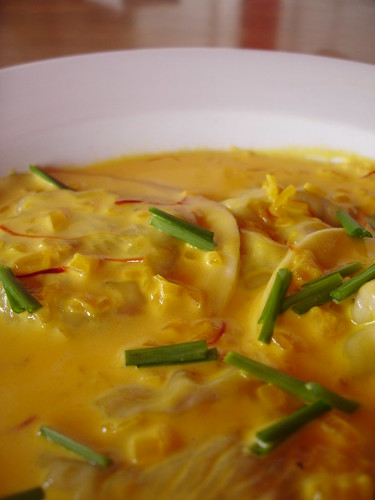






 I think I mentioned Paul Bertolli’s
I think I mentioned Paul Bertolli’s 

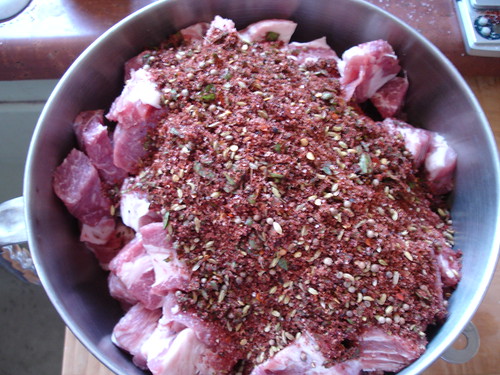

 After that it was into the paddle mixer where you mix the meat until it’s cohesive and sticky. Then it was time for a taste.
After that it was into the paddle mixer where you mix the meat until it’s cohesive and sticky. Then it was time for a taste.
 You’re supposed to check at this point to adjust for seasoning but the sausage was spiced and salty I almost went out to buy another hunk of pork to dilute it. I even used less seasoning than the recipe called for. But checking the recipe again, I noticed that their volume-to-mass conversions seemed off. The 8 grams of coriander they called for seemed to be substantially more than the one tablespoon equivalent in the recipe. Turns out, a tablespoon of coriander barely weighs 3 grams. All of weights were heavily overstated. How the hell did that happen? I can’t take out the salt they told me to put in. Who's to blame? Who can I sue?
You’re supposed to check at this point to adjust for seasoning but the sausage was spiced and salty I almost went out to buy another hunk of pork to dilute it. I even used less seasoning than the recipe called for. But checking the recipe again, I noticed that their volume-to-mass conversions seemed off. The 8 grams of coriander they called for seemed to be substantially more than the one tablespoon equivalent in the recipe. Turns out, a tablespoon of coriander barely weighs 3 grams. All of weights were heavily overstated. How the hell did that happen? I can’t take out the salt they told me to put in. Who's to blame? Who can I sue?
 But I soldiered on and got my sausage rig on the mixer and started stuffing away. Here I hit another snag: the KitchenAid attachment sucks ass. The idea is to cram a steady stream of meat into the machine so you can have nice, even sausages but what actually happens is that occasional bits go through the mixer and the rest comes oozing back around the edges of the crammer. At the same time, the sausage casing fills up with air bubbles.
But I soldiered on and got my sausage rig on the mixer and started stuffing away. Here I hit another snag: the KitchenAid attachment sucks ass. The idea is to cram a steady stream of meat into the machine so you can have nice, even sausages but what actually happens is that occasional bits go through the mixer and the rest comes oozing back around the edges of the crammer. At the same time, the sausage casing fills up with air bubbles.




 It sounds awful except for that over the past couple decades there have been around a dozen instances of
It sounds awful except for that over the past couple decades there have been around a dozen instances of  I’ve been resistant to buying pork after seeing that special on
I’ve been resistant to buying pork after seeing that special on 




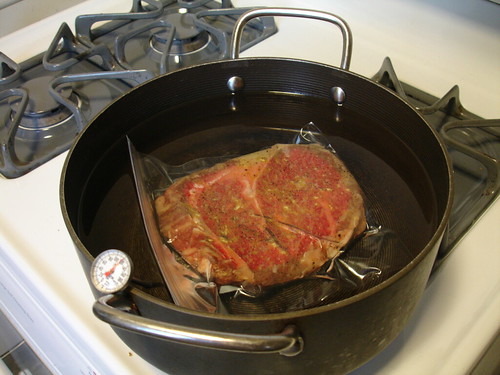


 It turns out I’m completely full of crap. After all my talk about organic this and sustainable that, I’m just a big glutton destined to be a future pity contestant on
It turns out I’m completely full of crap. After all my talk about organic this and sustainable that, I’m just a big glutton destined to be a future pity contestant on  But what could I do about it? Once my eyes settled on the menu, I couldn't help but focus on the appetizer sampler platter, the one with the quesadillas, chili cheese nachos, garlic fries, chicken tenders (yes, chicken), and onion rings. What wasn’t deep fried was covered in cheese. Wait, everything was deep fried and covered in cheese. Anyhow, the point is, the seductiveness of their offerings eclipsed my political correctness. When the platter arrived, I took the prison posture where I protected my plate with my left hand while shoveling food into my mouth with the right. It was impressive. But what earned me true hypocrite/glutton status was my ordering a side of macaroni and cheese on top of the appetizers. Who cares that it was mediocre? My calories per dollar ratio was off the charts.
But what could I do about it? Once my eyes settled on the menu, I couldn't help but focus on the appetizer sampler platter, the one with the quesadillas, chili cheese nachos, garlic fries, chicken tenders (yes, chicken), and onion rings. What wasn’t deep fried was covered in cheese. Wait, everything was deep fried and covered in cheese. Anyhow, the point is, the seductiveness of their offerings eclipsed my political correctness. When the platter arrived, I took the prison posture where I protected my plate with my left hand while shoveling food into my mouth with the right. It was impressive. But what earned me true hypocrite/glutton status was my ordering a side of macaroni and cheese on top of the appetizers. Who cares that it was mediocre? My calories per dollar ratio was off the charts.
 Thus, I feel it’s my responsibility to blog this great shame. All my talk of boycotting poultry means nothing. And I’m sure there was nothing on that plate that didn’t involve genetically modified crops and/or high fructose corn syrup. So you should stop reading this blog, toot sweet. I can’t be trusted.
Thus, I feel it’s my responsibility to blog this great shame. All my talk of boycotting poultry means nothing. And I’m sure there was nothing on that plate that didn’t involve genetically modified crops and/or high fructose corn syrup. So you should stop reading this blog, toot sweet. I can’t be trusted.
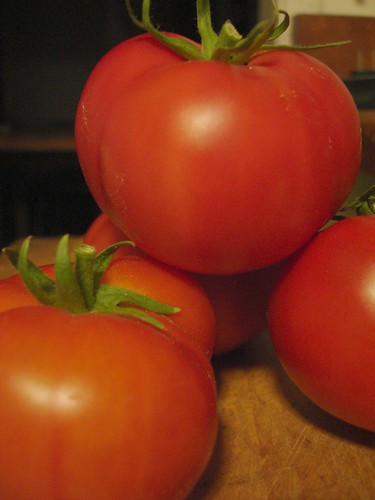 I’m harvesting way more tomatoes than I can eat (unless I wanted to do that awesome
I’m harvesting way more tomatoes than I can eat (unless I wanted to do that awesome 
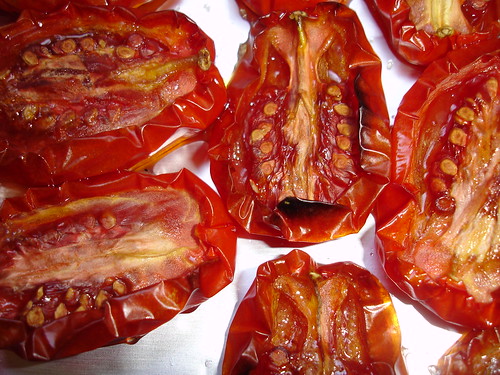 Your results may vary – oven fluctuations, tomato size – so after a couple hours, it’s best to check on them periodically. You’re looking for something that’s dried but pliant with just a tiny bit of juice. You don’t want a sun-dried tomato.
Your results may vary – oven fluctuations, tomato size – so after a couple hours, it’s best to check on them periodically. You’re looking for something that’s dried but pliant with just a tiny bit of juice. You don’t want a sun-dried tomato.
 Pack them in olive oil and store them in the fridge. Put them in pasta, salad, sauces, sandwiches, or whatever. At least, that’s what I read. So far mine haven't made it beyond the antipasto plate.
Pack them in olive oil and store them in the fridge. Put them in pasta, salad, sauces, sandwiches, or whatever. At least, that’s what I read. So far mine haven't made it beyond the antipasto plate.